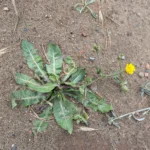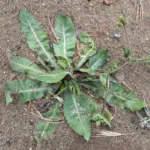Υποχοιρίς η αχυροφέρουσα
Etymology of Hypochaeris achyrophorus
The name Hypochaeris achyrophorus comes from Greek origins, but the genus name "Hypochaeris" is debated. It is said to be derived from the Ancient Greek "ὑποχοιρίς", from the combination of the words "ὑπό" (hypo), meaning "under," and "χοῖρος" (choiros), meaning "pig". The precise reasoning behind this name is debated, but one theory suggests it refers to pigs' affinity for the plant's edible roots. Another perspective links it to Theophrastus, a Greek philosopher, who used the name for this or a similar plant.
As a Greek-speaker, though, I can't figure out how "choiros" can be converted to "chaeris"; the correct translation of the Greek alphabet to Latin is "choeris", thus Hypochoeris, not Hypochaeris. There are actually listings on the internet of this genus with the correct translation, as Hypochoeris. The name Hypochaeris, though, was formally published and accepted in botanical literature. Under the rules of the International Code of Nomenclature for algae, fungi, and plants (ICN), once a genus name is validly published and widely used, it is preserved for the sake of nomenclatural stability, even if it contains a small etymological inaccuracy. So even if Hypochoeris might be a more literal rendering of "under-pig," the accepted name is Hypochaeris, and it cannot be arbitrarily changed now.
Another debated etymological explanation is the following: The genus name comes from the combination of the words "ὑπό" (hypo), meaning "under," and "χάρις" (charis), meaning "grace," "kindness," or "favour." Thus, the name is supposed to be interpreted as “less than graceful” or “under grace,” allegedly about the plant’s modest or humble appearance compared to showier relatives. This interpretation is consistent with a common tradition in botanical Latin where names subtly describe visual or ecological traits. But, this translation of the Greek alphabet to Latin also doesn't make sense, as "charis" has nothing to do with "chaeris", this would normally derive from "χαίρω" (chaero) in Greek, meaning "I'm glad".
This specific epithet "achyrophorus" is derived from the Greek "αχυροφόρος", from the combination of the words "άχυρο" (achyro), meaning "chaff", and "-φόρος" (phoros), meaning "wearer, bearer"; thus ", achyrophoros" is the epithet "chaff-bearer". It refers to the small, dense, scale-like structures (like husks or chaff in wheat) present on the receptacle of the flower head.
Key morphological characteristics
Hypochaeris achyrophorus, often known as Mediterranean Cat's-ear, is an annual herbaceous plant with several distinctive morphological characteristics.
Height
It typically grows as a small herb, reaching heights of 7 to 40 cm.
Leaves
The plant forms a basal rosette of leaves, which are quite variable in shape but generally obovate or oblong-obovate, ranging from 1.5 to 10.0 cm long and 0.5 to 3.0 cm wide. These leaves can be subentire, entire, or dentate, with a rounded or obtuse apex and a petiole-like attenuate base, and are often hispidulous (minutely hairy).
Stem
The flowering stems are erect and can be branched or unbranched, often appearing nearly leafless.
Flowers
The plant produces typical yellow, dandelion-like composite flower heads. These capitula are campanulate (bell-shaped) during flowering, measuring 6.0 to 13.0 mm long. The involucral bracts (the modified leaves surrounding the flower head) are linear, densely hispid dorsally, with outer bracts up to 5.0 mm long and inner ones up to 13.0 mm long, being acute or subacute with scarious (dry, membranous) margins. A crucial diagnostic feature, and the one referenced in its specific epithet, is the presence of scales on the receptacle (the part of the flower stalk where the florets are attached), giving it a "chaff-bearer" appearance. The flowers themselves are entirely ligulate (strap-shaped petals), with yellow corollas.
Achenes
The achenes (fruits) are dimorphic, meaning they come in two forms. The outer achenes are somewhat curved, narrowly cylindrical-fusiform, transversely wrinkled, and dark brown, typically lacking a beak and remaining enclosed by the persistent inner involucral bracts. The inner achenes are almost straight, longer, and possess a filiform beak, along with a brownish pappus (a structure of hairs aiding in wind dispersal) composed of two rows of hairs – outer scabridulous (roughened) hairs and inner plumose (feathery) hairs that are distinctly flattened and shortly fused at the base.
This combination of an annual habit, rosette leaves, branched stems, and particularly the dimorphic achenes and chaffy receptacle, helps distinguish Hypochaeris achyrophorus from other similar yellow-flowered composites.
Habitat of Hypochaeris achyrophorus
Hypochaeris achyrophorus is native to Cyprus. It is part of a wider native range that spans the Mediterranean region, including parts of North Africa, Western Asia (like Israel, Lebanon, Syria, and Turkey), and Southern Europe (such as Albania, Greece, Italy, France, and Spain).
As a typical Mediterranean annual, Hypochaeris achyrophorus thrives in dry and semi-arid conditions. Its general habitat preferences in the Mediterranean are disturbed grounds, open grassy areas, roadsides, fallow fields, garrigue and phrygana vegetation. It is often found in areas with poor or stony soils.
Hypochaeris achyrophorus in Cyprus
This plant exists all around the island up to an elevation of 950 meters. It is, though, an uncommon plant to encounter. Its flowering period is usually between March and May.



